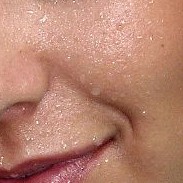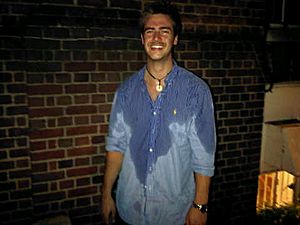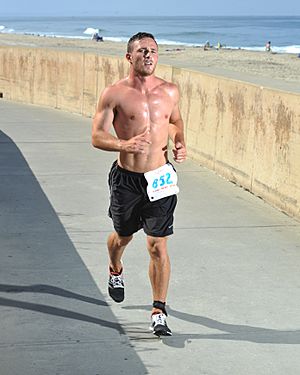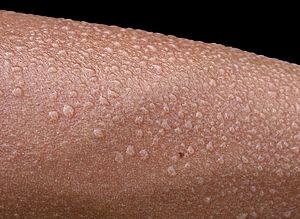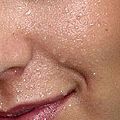Sweat facts for kids
Sweat is a liquid your skin makes when your body gets hot. It's also called perspiration. Sweat is made in tiny factories called sweat glands, which are just under your skin. It comes out through tiny holes in your skin called pores. Sweat is mostly water, but it also has some salts in it.
Your body makes sweat to cool itself down. When sweat touches your skin, it takes heat from your body as it evaporates (turns into a gas). Think of it like a natural air conditioner!
Sometimes, people worry that sweat makes them smell bad. Many people use special sprays or sticks to help with this. Deodorants help hide the odor of sweat. Anti-perspirants actually stop your body from sweating as much.
Sweat also helps your body get rid of some waste products.
Your body has over 4 million sweat glands! They are almost everywhere on your body, except for your lips, nipples, and some private areas. These glands are found in the middle layer of your skin, called the dermis.
Contents
What are Sweat Glands?
A sweat gland is like a long, curled tube made of cells. The curled part deep in your skin is where sweat is made. The long, straight part is a tube that carries the sweat to the tiny pore on the surface of your skin. Nerve cells tell your sweat glands when to start working.
There are two main types of sweat glands:
- Eccrine glands
- These are the most common type. You can find them all over your body, especially on your hands, feet, and forehead.
- They are smaller and start working from the time you are born.
- The sweat they make is mostly water and doesn't have proteins.
- Apocrine glands
How Your Body Makes Sweat
You are always sweating, even if you don't notice it! Sweating is your body's main way to get rid of extra heat. This heat comes from your body working, like when your muscles move. How much sweat you make depends on how you feel and what you are doing.
Sweat can be made when nerves tell your body to, when the air is hot, or when you exercise. Let's look at how eccrine sweat glands make sweat.
When a sweat gland gets a signal, its cells release a fluid. This fluid is a lot like the liquid part of your blood, called plasma. It's mostly water with a lot of sodium and chloride (which are salts). This fluid comes from the tiny blood vessels (capillaries) in your skin.
The fluid travels from the curled part of the gland up through the straight tube. What happens next depends on how fast you are sweating:
- When you sweat a little (like when you're resting)
- The cells in the tube have enough time to take back most of the salt and some water from the fluid.
- So, not much sweat reaches the outside of your skin.
- The sweat that does come out has less salt.
- When you sweat a lot (like when you exercise)
- The cells in the tube don't have enough time to take back all the salt and water.
- So, a lot of sweat reaches the surface of your skin.
- This sweat has more salt in it, similar to the fluid that started in the gland.
Apocrine sweat glands make sweat in a similar way. However, the sweat from apocrine glands also has proteins and fatty acids. These make the sweat thicker and sometimes yellowish. This is why armpit stains on clothes can look yellow.
Sweat itself doesn't have a smell. But when tiny living things called bacteria on your skin and hair eat the proteins and fatty acids in apocrine sweat, they create an unpleasant smell. This is why people put deodorants and anti-perspirants on their armpits.
A person who is not used to hot weather can make about one liter of sweat in an hour. But if you move to a hot place, your body can learn to make two to three liters of sweat per hour in about six weeks! This is the most sweat your body can usually make.
Why Sweat is Important
When sweat evaporates from your skin, it takes extra heat away and cools you down. This is a cool science trick! To change water from a liquid to a gas (vapor), it needs a certain amount of heat. This heat energy makes the water molecules move faster and escape into the air.
So, if you sweat a lot, your body can remove a lot of heat. For example, if you sweat one liter (about 1000 grams) in an hour, your body can get rid of a lot of heat energy. Not all sweat evaporates; some just runs off your skin. Also, your body loses heat in other ways, like directly from your skin to the air, and when you breathe out.
How well sweat cools you depends a lot on how much moisture is in the air around you. If the air is humid, it already has a lot of water vapor. This means your sweat can't evaporate as easily, so you don't cool down as well. This is why hot, humid days feel so much hotter!
When the water in sweat evaporates, it leaves the salts (like sodium and chloride) behind on your skin. This is why your skin can taste salty. Losing too much salt and water can make you very sick. It's super important to drink plenty of fluids when you exercise or are in hot weather. Sports drinks can help replace the salts you lose in sweat.
How Emotions Affect Sweating
Your feelings can also make you sweat! When you are nervous, worried, or scared, your body gets a signal to increase activity in your nerves. This also causes a chemical called epinephrine to be released. These signals tell your sweat glands, especially those on your hands and armpits, to make sweat. This is why you might feel a "cold sweat."
The increased nerve activity in your skin also changes how electricity moves through it. This is the idea behind how lie detector tests work.
Sweating Too Much
Sometimes, people sweat too much, especially on their hands or armpits. If this happens without being caused by emotions or physical activity, it's called diaphoresis or hyperhidrosis. It can be an embarrassing problem. The reasons why it happens are not always clear, but it might be due to:
- Changes in your body's chemicals (like during menopause in women).
- An overactive thyroid gland (which makes your body work faster and produce more heat).
- Certain foods or medicines (like coffee, which has a lot of caffeine).
- Your nervous system being too active.
The good news is that this condition can often be treated.
Images for kids
See also
 In Spanish: Sudor para niños
In Spanish: Sudor para niños


